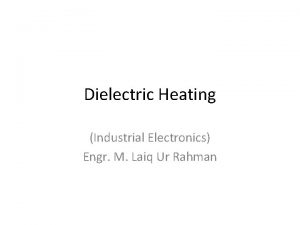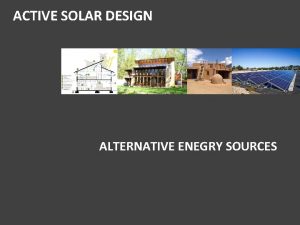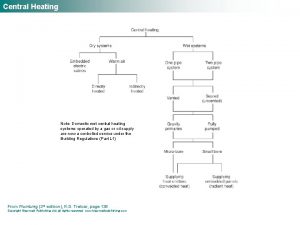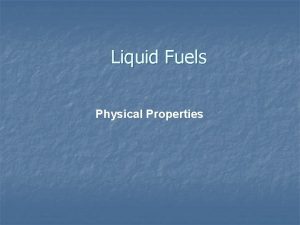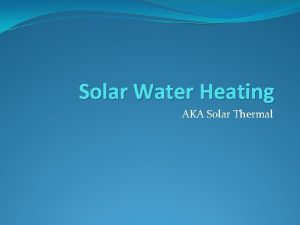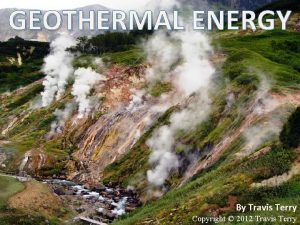Active Solar Heating Liquid Solar Heating System Travis















- Slides: 15

Active Solar Heating Liquid Solar Heating System Travis Ricard

Objective To outline and provide relevant information on the following l What is Active Solar Heating How Does a Liquid Active Solar Heating System Work In-Floor Radiant Heating Controls Performance and Maintenance l Cost and savings l l

What is Active Solar Heating l A system which relies upon the collection and storage of solar radiation in order to be transferred into energy for the purpose of heating

How Does a Liquid Active Solar Heating System Work l Solar radiation collectors are installed to collect direct sunlight l Usually placed on the roof, but they can also be wall or ground mounted http: //www. siberg. com/Solareg%20 SC 2_dosyalar/image 001. jpg

l A liquid is circulated through the collector l Usually consists of water, antifreeze, or methyl alcohol l The heat collected by the collector is transferred to the liquid

l A photovoltaic panel attached to the collectors operates a pump which circulates the liquid l The heated liquid is pumped into the storage container l Cold water from the storage container is then sent through the system be heated. http: //greenbuildings. santa-monica. org/images/ws 6. jpg

http: //homepage. eircom. net/~solaris/pages/products 1. html l The heated water can then be used with the aid of a heat exchanger to provide hot water or in floor radiant heating. l Often a secondary heating device is used when there is not enough solar radiation to heat the water l This device is typically a natural gas boiler

In-Floor Radiant Heating http: //www. radiantmax. com/assets/r-slab. gif l Liquid active solar heating systems are often used to supply hot water for in-floor radiant heating l The hot water is directed through plastic or rubber pipes embedded in a concrete floor l The circulating hot water then heats the floor, which in turn radiates to heat the room

l In floor radiant systems require water temperatures of 71. 1°C to 82. 2°C l Often these temperatures cannot be achieved through solar heating alone. l Typically the secondary system (natural gas boiler) is used to bring the pre-heated water up to the required temperature.

Controls l More complex then the typical household heating system l This is due to the fact that the system must analyze more signals and control more devices l Use sensors, switches, and motors to operate the system and to provide back-up heating l The main component of the system is the differential thermostat, which measures the difference in temperature between the collectors and storage container. l When the collectors are 6. 7°C to 12. 2°C warmer than the storage unit, thermostat turns on the pump to circulate water through the collector to heat the storage container or the house.

Performance l Quality, durability, system design, and installation dictate how well an active solar energy system will perform l Active solar energy systems typically provide 40% to 80% of the home's heating needs. l Systems providing less than 40% of the heat needed for a home are usually not cost effective as they due not provide enough savings to justify their more expensive implementation costs l The size of the system determines how much heat it can provide.

Maintenance l Most systems require between 8 -16 hours of maintenance ensure optimal performance and to avoid failures. l Much of this maintenance involves checking pipes and ductwork for leaks and collectors for damage. l Pumps and fans must also be cleaned and lubricated on an annual basis

Cost and Savings l Typical costs of solar radiation collectors vary from $30 and $80 per square foot installed (depending on the type of panel) l Further cost associated with storage container and pumping system l It is estimated that an in floor radiant heating system can reduce a heating bill by 20 -40% l This value will increase further if the secondary heating system is used as little as possible.

Conclusion l Liquid Active Solar Heating Systems are a cost effective and efficient way to heat a home l Reliable and relatively maintenance free l Many options with regard to type and size of system l The higher initial cost is quickly off set by the annual energy savings

References Refer to the below links for further information l http: //www. healthgoods. com/Education/Energy_Information/Ren ewable_Energy/heating_with_active_solar. htm l http: //www. newenergy. org/sesci/publications/pamphlets/active. ht ml
 Dielectric heating formula
Dielectric heating formula Theories of breakdown in liquid dielectrics
Theories of breakdown in liquid dielectrics Sieve tray tower
Sieve tray tower Active high and active low
Active high and active low Active transport
Active transport Primary active transport vs secondary active transport
Primary active transport vs secondary active transport Active solar design
Active solar design Wholesale solar battery solutions
Wholesale solar battery solutions An inexhaustible source of energy
An inexhaustible source of energy F&e heating system diagram
F&e heating system diagram What is a contemporary health issue
What is a contemporary health issue Social bond theory criminology
Social bond theory criminology How long did the texans defend the alamo
How long did the texans defend the alamo Travis county texas gis
Travis county texas gis Travis hill abc
Travis hill abc Travis heffernan
Travis heffernan
